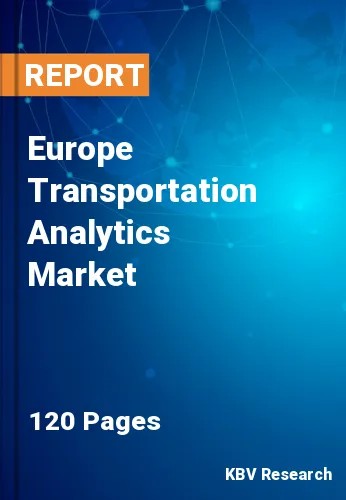The Europe Transportation Analytics Market would witness market growth of 18.1% CAGR during the forecast period (2022-2028).
The use of technology for fleet management is also contributing to the improvement of transportation efficiency. Vehicles maintain constant communication with various systems in order to get information about themselves, including how long they have been driving, where they are heading, and which route is the most time and fuel effective.
These solutions decrease the amount of time that drivers spend idling, enhance fuel economy, raise safety standards, and reduce the amount of paperwork required. This constant link between vehicles and warehouses or production facilities also makes it possible to respond in real-time to unforeseen situations and increases the flexibility with which one can respond to them.
Businesses are able to plan farther forward than just today's cargo when using digital freight platforms since these platforms increase the level of openness in the shipping industry. Shippers may be able to see regional patterns, information about particular lanes' costs, and drivers' preferences thanks to technological advancements. At the same time, carriers may get details such as loading/unloading durations and lane history data. Having access to all of this information may be helpful in reducing operational expenses without affecting service quality.
The French government is interested in the development of 5G and quantum technologies. These technologies will be of use in the process of developing the mobility of the future, namely the creation of connected and autonomous cars. In addition, there will be an emphasis placed on the development of digital technologies for mobility 3.0. Some examples of these technologies include sensor technology, wireless communications, computing, real-time and localization technologies, electronic payment, traffic management, flow, and security, as well as fleet and freight management. As a direct consequence of all of these factors, the need for transportation analytics would increase considerably all over the world.
The Germany market dominated the Europe Transportation Analytics Market by Country in 2021, and would continue to be a dominant market till 2028; thereby, achieving a market value of $2,953.9 Million by 2028. The UK market is estimated to grow a CAGR of 17.1% during (2022 - 2028). Additionally, The France market would exhibit a CAGR of 19% during (2022 - 2028).
Based on Application, the market is segmented into Traffic & Incident Management, Traffic Planning & Maintenance, Logistics Management, and Others. Based on Deployment Mode, the market is segmented into On-premise, Cloud, and Hybrid. Based on Type, the market is segmented into Descriptive, Prescriptive, and Predictive. Based on Component, the market is segmented into Solution and Services. Based on Mode of Transport, the market is segmented into Roadways, Railways, Airways, and Waterways. Based on countries, the market is segmented into Germany, UK, France, Russia, Spain, Italy, and Rest of Europe.
Free Valuable Insights: The Global Transportation Analytics Market will Hit $37.4 Billion by 2028, at a CAGR of 18.7%
The market research report covers the analysis of key stake holders of the market. Key companies profiled in the report include IBM Corporation, INRIX, Inc., Indra Sistemas, S.A., Cubic Corporation (Veritas Capital Fund Management, LLC), TomTom N.V., Siemens AG, Alteryx, Inc., Kapsch TrafficCom AG (Datax Handelsgmbh), Trimble, Inc., and Cellint Traffic Solutions Ltd.
By Application
By Deployment Mode
By Type
By Component
By Mode of Transport
By Country
Our team of dedicated experts can provide you with attractive expansion opportunities for your business.

